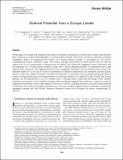| dc.contributor.author | Pappalardo, R. T. | |
| dc.contributor.author | Vance, S. | |
| dc.contributor.author | Bagenal, F. | |
| dc.contributor.author | Bills, B. G. | |
| dc.contributor.author | Blaney, D. L. | |
| dc.contributor.author | Blankenship, D. D. | |
| dc.contributor.author | Brinckerhoff, W. B. | |
| dc.contributor.author | Connerney, J. E. P. | |
| dc.contributor.author | Hand, K. P. | |
| dc.contributor.author | Hoehler, Tori M. | |
| dc.contributor.author | Leisner, J. S. | |
| dc.contributor.author | Kurth, W. S. | |
| dc.contributor.author | McGrath, M. A. | |
| dc.contributor.author | Mellon, M. T. | |
| dc.contributor.author | Moore, J. M. | |
| dc.contributor.author | Patterson, G. W. | |
| dc.contributor.author | Prockter, L. M. | |
| dc.contributor.author | Senske, D. A. | |
| dc.contributor.author | Schmidt, B. E. | |
| dc.contributor.author | Shock, E. L. | |
| dc.contributor.author | Soderlund, K. M. | |
| dc.contributor.author | Smith, David Edmund | |
| dc.date.accessioned | 2013-10-18T16:13:52Z | |
| dc.date.available | 2013-10-18T16:13:52Z | |
| dc.date.issued | 2013-08 | |
| dc.date.submitted | 2013-03 | |
| dc.identifier.issn | 1531-1074 | |
| dc.identifier.issn | 1557-8070 | |
| dc.identifier.uri | http://hdl.handle.net/1721.1/81431 | |
| dc.description.abstract | The prospect of a future soft landing on the surface of Europa is enticing, as it would create science opportunities that could not be achieved through flyby or orbital remote sensing, with direct relevance to Europa's potential habitability. Here, we summarize the science of a Europa lander concept, as developed by our NASA-commissioned Science Definition Team. The science concept concentrates on observations that can best be achieved by in situ examination of Europa from its surface. We discuss the suggested science objectives and investigations for a Europa lander mission, along with a model planning payload of instruments that could address these objectives. The highest priority is active sampling of Europa's non-ice material from at least two different depths (0.5–2 cm and 5–10 cm) to understand its detailed composition and chemistry and the specific nature of salts, any organic materials, and other contaminants. A secondary focus is geophysical prospecting of Europa, through seismology and magnetometry, to probe the satellite's ice shell and ocean. Finally, the surface geology can be characterized in situ at a human scale. A Europa lander could take advantage of the complex radiation environment of the satellite, landing where modeling suggests that radiation is about an order of magnitude less intense than in other regions. However, to choose a landing site that is safe and would yield the maximum science return, thorough reconnaissance of Europa would be required prior to selecting a scientifically optimized landing site. | en_US |
| dc.language.iso | en_US | |
| dc.publisher | Mary Ann Liebert | en_US |
| dc.relation.isversionof | http://dx.doi.org/10.1089/ast.2013.1003 | en_US |
| dc.rights | Article is made available in accordance with the publisher's policy and may be subject to US copyright law. Please refer to the publisher's site for terms of use. | en_US |
| dc.source | Mary Ann Liebert | en_US |
| dc.title | Science Potential from a Europa Lander | en_US |
| dc.type | Article | en_US |
| dc.identifier.citation | Pappalardo, R.T., S. Vance, F. Bagenal, B.G. Bills, D.L. Blaney, D.D. Blankenship, W.B. Brinckerhoff, et al. “Science Potential from a Europa Lander.” Astrobiology 13, no. 8 (August 2013): 740-773. © 2013 Mary Ann Liebert, Inc. | en_US |
| dc.contributor.department | Massachusetts Institute of Technology. Department of Earth, Atmospheric, and Planetary Sciences | en_US |
| dc.contributor.mitauthor | Smith, David Edmund | en_US |
| dc.relation.journal | Astrobiology | en_US |
| dc.eprint.version | Final published version | en_US |
| dc.type.uri | http://purl.org/eprint/type/JournalArticle | en_US |
| eprint.status | http://purl.org/eprint/status/PeerReviewed | en_US |
| dspace.orderedauthors | Pappalardo, R.T.; Vance, S.; Bagenal, F.; Bills, B.G.; Blaney, D.L.; Blankenship, D.D.; Brinckerhoff, W.B.; Connerney, J.E.P.; Hand, K.P.; Hoehler, T.M.; Leisner, J.S.; Kurth, W.S.; McGrath, M.A.; Mellon, M.T.; Moore, J.M.; Patterson, G.W.; Prockter, L.M.; Senske, D.A.; Schmidt, B.E.; Shock, E.L.; Smith, D.E.; Soderlund, K.M. | en_US |
| mit.license | PUBLISHER_POLICY | en_US |
| mit.metadata.status | Complete | |
